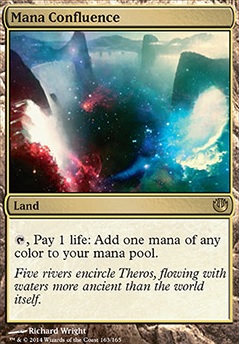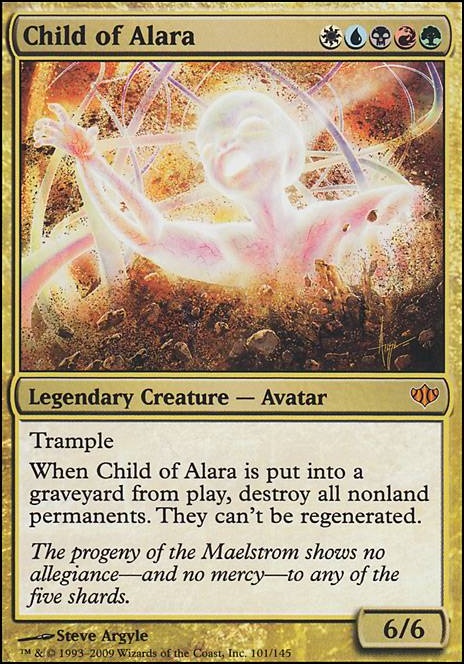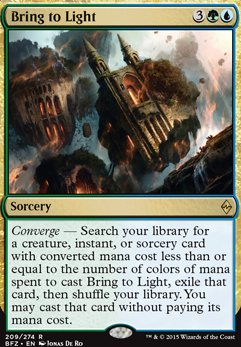Land (37)
- 1x Ancient Tomb
- 1x Arid Mesa
- 1x Bloodstained Mire
- 1x Bojuka Bog
- 1x Breeding Pool
- 1x Brushland
- 1x Caves of Koilos
- 1x Cephalid Coliseum
- 1x City of Brass
- 1x Command Tower
- 1x Exotic Orchard
- 1x Flooded Strand
- 1x Forbidden Orchard
- 3x Forest
- 1x Gaea's Cradle
- 1x Godless Shrine
- 1x Hallowed Fountain
- 1x High Market
- 1x Llanowar Wastes
- 1x Mana Confluence
- 1x Marsh Flats
- 1x Misty Rainforest
- 1x Overgrown Tomb
- 1x Plains
- 1x Polluted Delta
-
1x
Reflecting Pool

- 1x Stomping Ground
- 1x Swamp
- 1x Tarnished Citadel
- 1x Temple Garden
- 1x Urborg, Tomb of Yawgmoth
- 1x Verdant Catacombs
- 1x Watery Grave
- 1x Windswept Heath
- 1x Wooded Foothills
Tutor (17)
- 1x Academy Rector
- 1x Birthing Pod
- 1x Bring to Light
- 1x Demonic Tutor
- 1x Dimir House Guard
- 1x Eladamri's Call
- 1x Enlightened Tutor
- 1x Fauna Shaman
- 1x Green Sun's Zenith
- 1x Heliod's Pilgrim
- 1x Jarad's Orders
- 1x Praetor's Grasp
- 1x Shred Memory
- 1x Sidisi, Undead Vizier
- 1x Vampiric Tutor
- 1x Wild Pair
- 1x Worldly Tutor
Interaction (14)
- 1x Acidic Slime
- 1x Anafenza, the Foremost
- 1x Bojuka Bog
- 1x Eidolon of Rhetoric
- 1x Fiend Hunter
- 1x Harmonic Sliver
- 1x Mindslicer
- 1x Peacekeeper
- 1x Reflector Mage
- 1x Shriekmaw
- 1x Sire Of Insanity
- 1x Song of the Dryads
- 1x Spirit of the Labyrinth
Utility (9)
Commander (1)
Combo (16)
- 1x Academy Rector
- 1x Altar of Dementia
- 1x Animate Dead
- 1x Body Double
- 1x Boonweaver Giant
- 1x Carrion Feeder
- 1x Dimir House Guard
- 1x Fiend Hunter
- 1x Goblin Bombardment
- 1x Karmic Guide
- 1x Pattern of Rebirth
- 1x Phantasmal Image
- 1x Reveillark
- 1x Saffi Eriksdotter
- 1x Sun Titan
- 1x Viscera Seer
Fixing/Ramp (12)
Maybeboard
Other (43)
- 1x Beast Within
- 1x Blasting Station
- 1x Blood Artist
- 1x Bloom Tender
- 1x Bone Shredder
- 1x Buried Alive
- 1x Carpet of Flowers
- 1x Cartel Aristocrat
- 1x Chromatic Lantern
- 1x Coalition Relic
- 1x Collective Restraint
- 1x Crypt Champion
- 1x Dack's Duplicate
- 1x Dance of the Dead
- 1x Deathrite Shaman
- 1x Eldritch Evolution
- 1x Elesh Norn, Grand Cenobite
- 1x Entomb
- 1x False Prophet
- 1x Gift of Immortality
- 1x Glen Elendra Archmage
- 1x Hushwing Gryff
- 1x Intuition
- 1x Lotus Cobra
- 1x Loyal Retainers
- 1x Necromancy
- 1x Painful Truths
- 1x Path to Exile
- 1x Pernicious Deed
- 1x Phyrexian Metamorph
- 1x Phyrexian Tower
- 1x Priest of Titania
- 1x Reanimate
- 1x Reclamation Sage
- 1x Recruiter of the Guard
- 1x Renegade Rallier
- 1x Rune-Scarred Demon
- 1x Sensei's Divining Top
- 1x Skullclamp
- 1x Survival of the Fittest
- 1x Swan Song
- 1x Wargate
- 1x Weathered Wayfarer
Suggestions
Comments View Archive
Attention! Complete Comment Tutorial! This annoying message will go away once you do!
Important! Formatting tips — Comment Tutorial — markdown syntax
Please login to comment
| Date added | 10 years |
| Last updated | 7 years |
| Legality | This deck is Commander / EDH legal. |
| Rarity (main - side) | 4 - 0 Mythic Rares 58 - 0 Rares 19 - 0 Uncommons 14 - 0 Commons |
| Cards | 100 |
| Avg. CMC | 2.76 |
| Tokens | Morph 2/2 C, Spirit 1/1 C |
| Folders | Pentacolor , EDH Comander , Bookmarked, Decks to View |
| Votes | |
| Ignored suggestions | |
| Shared with | |
| Views |








 -
- 



 If you control
If you control  If a second
If a second 
 The commander
The commander  Naturally, every deck has its weaknesses. The big one for this deck is clearly its mana: Being five colors, something like
Naturally, every deck has its weaknesses. The big one for this deck is clearly its mana: Being five colors, something like  Further, all the available combos involve creatures going into the graveyard and returning from there, so everything that interacts with this will be a problem (
Further, all the available combos involve creatures going into the graveyard and returning from there, so everything that interacts with this will be a problem ( Creature removal can be annoying, but is generally only slowing us down, as the redundancy of the deck allows it to play on very well. Some possible creature loops even work through removal (any combination of two out of
Creature removal can be annoying, but is generally only slowing us down, as the redundancy of the deck allows it to play on very well. Some possible creature loops even work through removal (any combination of two out of  While removal on our creatures is something we can live with, a well timed
While removal on our creatures is something we can live with, a well timed  Countermagic is a little better than removal against us, but this deck has a number of must-counter threats like
Countermagic is a little better than removal against us, but this deck has a number of must-counter threats like  Static hate effects like
Static hate effects like  Effects that exile specific cards directly from our deck like
Effects that exile specific cards directly from our deck like 
